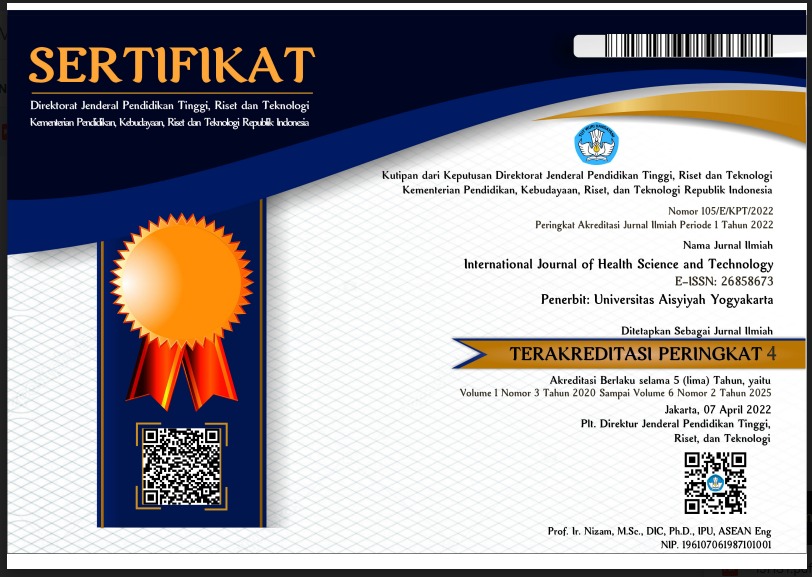Evaluation of CT angiography of the thoracic aorta with ECG gating in cases of dissection
DOI:
https://doi.org/10.31101/ijhst.v6i1.3668Abstract views 185 times
Keywords:
Aortic dissection, ECG gating, CT Angiography, Post processingAbstract
Downloads
References
Chandra, H., Ekowati, A., & Artsinis, E. (2016). Diseksi Aorta Ascendens Tipe Stanford A dengan Hemiparese Kiri. Jurnal Radiologi Indonesia, 2(1), 22–29. https://doi.org/10.33748/jradidn.v2i1.41
Dewi, N. I. A. (2020). Diagnosis Dan Tatalaksana Dini Diseksi Aorta. Ibnu Sina Jurnal Kedokteran Dan Kesehatan-Fakultas Kedokteran Universitas Islam Sumatera Utara, 19(1), 28–39. https://doi.org/10.30743/ibnusina.v19i1.12
Duran, E. S., Ahmad, F., Elshikh, M., Masood, I., & Duran, C. (2019). Computed Tomography Imaging Findings of Acute Aortic Pathologies. Cureus, 11(8). https://doi.org/10.7759/cureus.5534
Horehledova, B., Mihl, C., Boswijk, E., Crombag, G. a. J. C., Nijssen, E. C., Nelemans, P. J., Veenstra, L. F., Wildberger, J. E., & Das, M. (2020). Retrospectively ECG-gated helical vs. non-ECG-synchronized high-pitch CTA of the aortic root for TAVI planning. PLoS ONE, 15(5), e0232673. https://doi.org/10.1371/journal.pone.0232673
Kalisz, K., Buethe, J., Saboo, S. S., Abbara, S., Halliburton, S., & Rajiah, P. (2016). Artifacts at Cardiac CT: Physics and Solutions. Radiographics, 36(7), 2064–2083. https://doi.org/10.1148/rg.2016160079
Kartawiguna, D., & Rusmini. (2017). Multi Slice Computed Tomography (MSCT) Multi Slice Computed Tomography (MSCT) 1. 1(c), 174.
Ko, J. P., Goldstein, J. M., Latson, L. A., Azour, L., Gozansky, E. K., Moore, W., Patel, S., & Hutchinson, B. (2021). Chest ct angiography for acute aortic pathologic conditions: Pearls and pitfalls. Radiographics, 41(2), 399–424. https://doi.org/10.1148/rg.2021200055
Kornberger, A., Burck, I., El Beyrouti, H., Halloum, N., Beiras-Fernandez, A., & Vahl, C. F. (2018). A low threshold to ECG-gated repeat CTA reduces the risk of false-positive diagnosis of type a dissection in interhospital referrals: A case series study. Therapeutics and Clinical Risk Management, 14, 2019–2027. https://doi.org/10.2147/TCRM.S166555
Marbun, J. M. H. (2016). Diseksi Aorta: Kegawatdaruratan Kardiovaskular. Cermin Dunia Kedokteran. 43(12), 892–895. https://dx.doi.org/10.55175/cdk.v43i12.895
Melvinsdottir, I. H., Lund, S. H., Agnarsson, B. A., Sigvaldason, K., Gudbjartsson, T., & Geirsson, A. (2016). The incidence and mortality of acute thoracic aortic dissection: Results from a whole nation study. European Journal of Cardio-Thoracic Surgery, 50(6), 1111–1117. https://doi.org/10.1093/ejcts/ezw235
Michalowska, I., Szpakowski, E., Furmanek, M., Kusmierczyk, M., Oleksiuk, T., Kwiatek, P., Janaszek-Sitkowska, H., Legaszewski, T., & Rózanski, J. (2019). Assessment of intimal tears in thoracic aortic dissection using ecg-gated dual-source computed tomography. Kardiochirurgia i Torakochirurgia Polska, 10(2), 171–176. https://doi.org/10.5114/kitp.2013.36144
Pierro, A., Cilla, S., Totaro, A., Ienco, V., Sacra, C., De Filippo, C. M., & Sallustio, G. (2018). ECG-gated CT angiography of the thoracic aorta: the importance of evaluating the coronary arteries. Clinical Radiology, 73(11), 983.e1-983.e6. https://doi.org/10.1016/j.crad.2018.06.016
Seeram, E. (2016). Computer tomography Physical Principles, Clinical Applications, and Quality Control (fourth edi).
Susanti, T., Arinawati, A., & Sulaksono, N. (2020). Peranan Heart Rate Terhadap Kualitas Citra Pada Pemeriksaan CT Angiography Cardiac. JRI (Jurnal Radiografer Indonesia), 3(2), 85–90. https://doi.org/10.55451/jri.v3i2.74
Vardhanabhuti, V., Nicol, E., Morgan-Hughes, G., Roobottom, C. A., Roditi, G., Hamilton, M. C. K., Bull, R. K., Pugliese, F., Williams, M. C., Stirrup, J., Padley, S., Taylor, A., Davies, L. C., Bury, R., & Harden, S. (2016). Recommendations for accurate CT diagnosis of suspected acute aortic syndrome (AAS)-on behalf of the British Society of Cardiovascular Imaging (BSCI)/British Society of Cardiovascular CT (BSCCT). British Journal of Radiology, 89(1061). https://doi.org/10.1259/bjr.20150705
Yanagaki, S., Ueda, T., Masuda, A., Ota, H., Onaka, Y., Kojima, M., Hattori, T., Mihara, W., & Takase, K. (2020). Detection of the intimal tear in aortic dissection and ulcer-like projection in intramural hematoma: usefulness of full-phase retrospective ECG-gated CT angiography. Japanese Journal of Radiology, 38(11), 1036–1045. https://doi.org/10.1007/s11604-020-01008-1
Downloads
Published
How to Cite
Issue
Section
License
Copyright (c) 2024 Mahfud Edy Widiatmoko, Eny Supriyaningsih, Shinta Gunawati Sutoro, Muhammad Irsal, Dewi Anggraeni

This work is licensed under a Creative Commons Attribution-ShareAlike 4.0 International License.
International Journal of Health Science and Technology allows readers to read, download, copy, distribute, print, search, or link to its articles' full texts and allows readers to use them for any other lawful purpose. The journal allows the author(s) to hold the copyright without restrictions. Finally, the journal allows the author(s) to retain publishing rights without restrictions
- Authors are allowed to archive their submitted article in an open access repository
- Authors are allowed to archive the final published article in an open access repository with an acknowledgment of its initial publication in this journal

This work is licensed under a Creative Commons Attribution-ShareAlike 4.0 Generic License.













